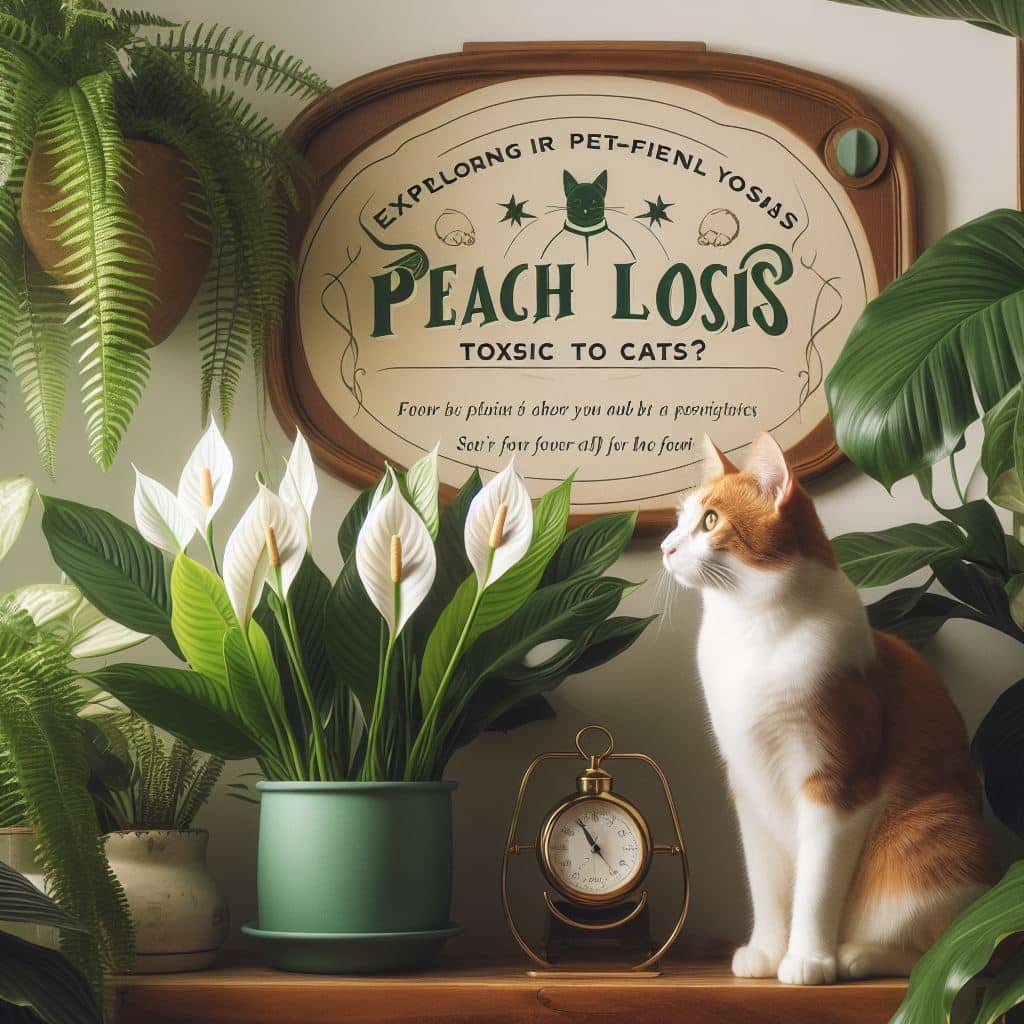Are peace lilies toxic to cats? Pet owners often wonder about the potential dangers of having peace lilies around their feline friends. In this blog post, we will delve into the toxicity of peace lilies to cats, how to identify them, symptoms of peace lily toxicity in cats, immediate actions to take if a cat ingests a peace lily, potential health risks, treatment options, preventive measures, and safe alternatives for cat-friendly homes. It’s crucial to stay informed and proactive in keeping our beloved pets safe from potential hazards.
The Toxicity of Peace Lilies to Cats
Peace lilies are popular household plants known for their elegant white blooms and air-purifying qualities. However, despite their aesthetic appeal, it’s important for cat owners to be aware of the potential dangers these plants pose to their feline companions. Here’s what you need to know about the toxicity of peace lilies to cats:

Toxic Components: Peace lilies contain calcium oxalate crystals, which are toxic to cats if ingested. When a cat chews or bites into the leaves or stems of a peace lily, it releases these crystals, leading to irritation and other adverse effects in the cat’s mouth and digestive system.
Symptoms: Cats that have ingested parts of a peace lily may exhibit symptoms such as drooling
.pawing at the mouth, vomiting, difficulty swallowing, and in severe cases, breathing difficulties. It’s important to be vigilant for these signs if you have a peace lily in your home and notice any unusual behavior in your cat.
- Severity of Toxicity: The toxicity of peace lilies to cats can vary in severity depending on the amount ingested and the individual cat’s sensitivity. While some cats may only experience mild symptoms, others could face more serious health complications.
Importance of Prompt Action: If you suspect that your cat has ingested parts of a peace lily, it’s crucial to seek immediate veterinary attention. Delay in treatment could exacerbate the situation and put your cat’s health at risk.
Cat owners should be mindful of the potential harm that peace lilies can pose to their pets. and take proactive measures to ensure a safe environment for their feline companions. In the following sections. we will delve deeper into identifying peace lilies and understanding the associated symptoms, as well as providing actionable steps for immediate intervention and long-term prevention.
Identifying Peace Lilies
When determining if your household plants pose a threat to your feline friend. it’s crucial to accurately identify the specific species. Peace lilies, scientifically known as Spathiphyllum, are popular indoor plants cherished for their elegant, glossy leaves and striking white blooms. Here’s how to recognize these common greenery and distinguish them from other flora in your home:
Are Peace Lilies Toxic to Cats? – Characteristics of Peace Lilies
To identify peace lilies and differentiate them from other plants, look for the following key features:

- Leaves: Peace lily leaves are long, glossy, and deep green in color, with a distinctive pointed shape at the tip.
- Flowers: These plants produce an exquisite white flower resembling a calla lily, consisting of a hood-like sheath called a spathe and a spadix.
Are Peace Lilies Toxic to Cats? – Growth Habit
Understanding the growth habits of peace lilies can help in their identification and differentiation from non-toxic greenery.
- Peace lilies typically grow to a height of 1-4 feet, creating a graceful and upright appearance.
- They are known for their ability to thrive in low-light conditions, making them commonly found in indoor environments.
Toxic Components
To comprehend the potential danger peace lilies pose to cats. it’s essential to be aware of the toxic substances they contain:

- Peace lilies contain insoluble calcium oxalates, which can cause severe oral and gastric irritation if ingested by cats.
By familiarizing yourself with these distinguishing characteristics, you can accurately determine whether a particular plant in your home is a peace lily. and assess the potential risk it may pose to your beloved feline companion. Remember, if you suspect that your cat has ingested any part of a peace lily, prompt action is crucial to ensure their health and safety.
Symptoms of Peace Lily Toxicity in Cats
If you suspect that your feline friend has ingested a peace lily, it’s crucial to be aware of the potential symptoms of peace lily toxicity in cats. Keep a close eye on your cat for the following signs, as they could indicate that your pet has been affected by the toxic properties of peace lilies:

- Gastrointestinal Distress: Cats may experience vomiting, drooling, or diarrhea after ingesting parts of a peace lily.
- Difficulty Swallowing: Your cat may show signs of discomfort or difficulty when swallowing, which can be a result of irritation caused by the plant’s toxins.
- Oral Irritation: Look out for pawing at the mouth, as well as redness or swelling in and around the oral cavity.
- Lethargy: If your cat appears unusually tired or weak, it could be a sign of peace lily toxicity.
- Loss of Appetite: A sudden disinterest in food may indicate that your cat is feeling unwell due to ingesting a peace lily.
- Kidney Damage: In severe cases, peace lily ingestion can lead to kidney damage, so observe your cat for changes in urination patterns or increased thirst.
It’s important to note that these symptoms may vary in severity depending on the amount of the plant ingested and the individual cat’s sensitivity. If you notice any of these symptoms and suspect peace lily toxicity. seeking prompt veterinary care is crucial to ensure the well-being of your beloved pet.
Immediate Actions if a Cat Ingests a Peace Lily
If you suspect or know that your cat has ingested a peace lily, it’s crucial to take immediate action to minimize potential harm. Here are the steps to follow:
Remove the plant: Quickly remove any remnants of the peace lily from your cat’s vicinity to prevent further ingestion.
Contact a veterinarian: Reach out to your veterinarian or call a pet poison hotline for guidance. Be ready to provide information such as your cat’s symptoms weight, and the quantity and parts of the peace lily consumed.
Observe your cat: Monitor your cat closely for any signs of distress or abnormal behavior. Symptoms of peace lily toxicity in cats may include vomiting, drooling, difficulty swallowing, and in severe cases, renal failure.
Do not induce vomiting: Refrain from inducing vomiting in your cat without professional advice, as it may worsen the situation.
Seek prompt medical attention: If advised by a professional, take your cat to the veterinarian for a thorough examination and appropriate treatment.
Reacting swiftly when your cat ingests a peace lily can significantly impact their well-being. Being proactive in seeking assistance from a veterinarian. is crucial in ensuring the best course of action to mitigate. any potential harm caused by peace lily toxicity in cats.
Potential Health Risks for Cats
Peace lilies, also known as Spathiphyllum, pose potential health risks to cats when ingested. The toxic principles in peace lilies, such as calcium oxalate crystals, can lead to various health issues for felines. To understand the potential health risks for cats. it’s crucial to delve into the specific effects of peace lily toxicity on these pets:

Oral and Gastrointestinal Irritation: When cats ingest parts of peace lilies, such as leaves or flowers, they can experience oral irritation, including drooling, pawing at the mouth, and difficulty swallowing. Gastrointestinal issues like vomiting, diarrhea, and abdominal pain may also occur.
Respiratory Distress: In severe cases of ingestion, cats may exhibit symptoms of respiratory distress, such as difficulty breathing, wheezing, and coughing. This can be a concerning and life-threatening consequence of peace lily toxicity.
Renal Complications: The consumption of peace lilies can lead to kidney damage in cats. If not addressed promptly, this could result in acute kidney failure, a serious and potentially fatal condition.
It’s essential for cat owners to recognize these potential health risks. and seek immediate veterinary care if their feline companions have ingested any part of a peace lily. Early intervention often plays a critical role in mitigating the harmful effects of peace lily toxicity on cats.
In comparison to other toxic plants. the potential health risks associated. with peace lilies emphasize the importance of creating a safe environment for cats by carefully assessing the plants within their living spaces.
Treatment for Peace Lily Toxicity in Cats
In the unfortunate event that a cat ingests a peace lily and shows signs of toxicity, prompt treatment is crucial. Here are the steps to take for treating peace lily toxicity in cats:

Immediate Action: If you suspect that your cat has ingested any part of a peace lily. Contact your veterinarian or the animal poison control hotline immediately. Time is of the essence in such situations.
Symptom Management: The veterinarian may begin by managing the symptoms of peace lily toxicity. This could involve treatments to control vomiting, diarrhea, and oral irritation.
Fluid Therapy: In cases of severe ingestion, the cat may require intravenous fluid therapy to maintain hydration and support kidney function.
Activated Charcoal: The administration of activated charcoal may be recommended by the veterinarian to help prevent the absorption of toxins in the cat’s stomach.
Monitoring and Support: After initial treatment, the cat may need to be closely monitored for any signs of deterioration or further complications.
Follow-up Care: Upon returning home. it’s essential to follow any medication schedules and recommendations provided by the veterinarian for the cat’s full recovery.
It’s important to remember that home remedies or treatments should not be attempted without professional guidance. as they can potentially worsen the condition. Seeking immediate veterinary care is the best course of action in cases of peace lily toxicity in cats.
Preventive Measures for Cat Owners
When it comes to keeping your feline friends safe from potential harm. including plants such as peace lilies, there are several preventive measures that you can take. Here are some effective ways to ensure the safety of your cats:

Placement: Place peace lilies in locations that are completely inaccessible to your cats. Consider hanging baskets or placing the plants in rooms that are off-limits to your pets.
Supervision: When your cats are roaming freely in the house, ensure that they are supervised, especially if there are peace lilies around. This allows you to intervene if you notice any attempts by your cats to nibble on the plants.
Deterrents: Use natural cat deterrents, such as citrus peels or aluminum foil. Around the base of the plants to discourage cats from getting too close.
- Education: Take the time to educate yourself and other members of your household about the potential dangers of peace lilies to cats. Awareness plays a crucial role in preventing accidental ingestion.
Alternative plants: If you are a cat owner, consider opting for cat-friendly plants as alternatives to peace lilies. There are plenty of beautiful and safe plants to choose from that won’t pose a threat to your furry companions.
By implementing these preventive measures. you can significantly reduce the risk of accidental ingestion of peace lilies by your cats, creating a safer environment for both your pets and your beloved plants.
Safe Alternatives to Peace Lilies for Cat-Friendly Homes
When looking for cat-friendly houseplants. it’s essential to consider alternatives to peace lilies that will beautifully complement your home while ensuring the safety and well-being of your beloved feline friends. Here are some safe alternatives to consider:

1. Spider Plant:
- Chlorophytum comosum, commonly known as the spider plant, is a popular choice and is non-toxic to cats.
- It is relatively easy to care for and can thrive in various lighting conditions, making it a versatile option for different areas of your home.
2. Boston Fern:
- The Nephrolepis exaltata, or Boston fern, is another cat-friendly option that adds a touch of lush greenery to your living space.
- This plant is considered safe for cats and can help to improve indoor air quality.
3. Areca Palm:
- The Dypsis lutescens, also known as the areca palm, is a cat-safe plant that can bring a tropical vibe to your home.
- With proper care, this plant can grow into a stunning, cat-friendly addition to your indoor garden.
4. African Violet:
- Saintpaulia, commonly referred to as the African violet. offers vibrant and colorful blooms without posing a threat to your feline companions.
- These small, cheerful plants are perfect for adding a pop of color to your living space.
By opting for these safe alternatives to peace lilies. You can create a cat-friendly environment while still enjoying the beauty of indoor plants. Always ensure that any plant you bring into your home is safe for your pets. Consider the specific needs of each plant to provide the best care for both your greenery and your furry friends.
Consulting a Veterinarian
If you suspect that your cat has ingested or come into contact with a peace lily and is showing signs of distress. it is crucial to seek immediate veterinary assistance. Consulting a veterinarian is the best course of action to ensure the well-being of your feline friend. Here’s why consulting a veterinarian is essential in cases of potential peace lily toxicity:
Expert Evaluation: A veterinarian can conduct a thorough examination to assess the extent of peace lily toxicity in your cat. They have the expertise to identify the symptoms and provide appropriate treatment.
Customized Treatment: Veterinarians can tailor treatment based on the severity of the peace lily toxicity. This may include inducing vomiting, administering activated charcoal, or providing supportive care to alleviate symptoms.
- Preventive Measures: In addition to treating the immediate effects of peace lily toxicity. Veterinarians can offer guidance on preventing future incidents. They can advise on pet-safe plants and how to create a cat-friendly environment.
- Follow-up Care: After initial treatment. veterinarians can monitor your cat’s recovery progress and address any lingering effects of peace lily toxicity.
- Peace of Mind: Consulting a veterinarian brings assurance and professional insight. offering peace of mind for pet owners during a concerning time.
Remember! swift action and seeking professional veterinary care. are crucial steps in safeguarding your cat’s health in cases of potential peace lily toxicity.
Conclusion: Keeping Cats Safe from Peace Lily Toxicity
In conclusion, it is crucial for cat owners to be aware of the potential dangers that peace lilies pose to their feline companions. While peace lilies are beloved for their aesthetic appeal, they can have severe consequences if ingested by cats. Understanding the toxicity of peace lilies to cats. and taking preventive measures is paramount in ensuring. the safety and well-being of our pets.
Key Points to Keep Cats Safe:
- Awareness: It’s important for cat owners to be knowledgeable about which plants are toxic to cats, including peace lilies.
- Plant Placement: Placing peace lilies out of reach of cats, either by hanging them or keeping them in areas inaccessible to pets, can prevent accidental ingestion.
- Regular Monitoring: Regularly monitoring the environment in which cats roam can help identify any potential exposure to peace lilies.
- Safe Alternatives: Opting for cat-friendly plants as alternatives to peace lilies can eliminate the risk of toxicity to cats.
- Prompt Veterinary Attention: If a cat shows any symptoms of peace lily toxicity, prompt veterinary attention is crucial for a quick and effective treatment.
By implementing these key points and being vigilant in ensuring the safety of our feline friends. We can create a secure and pet-friendly environment free from the perils of peace lily toxicity.
Remember, while peace lilies may bring peace and tranquility to our homes. They should not jeopardize the safety and health of our beloved cats.
Frequently Asked Questions
Are peace lilies toxic to cats?
Yes, peace lilies are toxic to cats. They contain calcium oxalate crystals. Which can cause oral and throat irritation, as well as vomiting, difficulty swallowing. Even difficulty breathing if ingested by cats.
What are the symptoms of peace lily poisoning in cats?
The symptoms of peace lily poisoning in cats include drooling, vomiting, difficulty swallowing. Lack of appetite, and in severe cases, difficulty breathing. It’s important to seek immediate veterinary care if you suspect your cat has ingested any part of a peace lily.
Can peace lilies be kept in a home with cats?
It is not recommended to keep peace lilies in a home with cats. Especially if the cats are known to be curious and may chew on plants. However, if you do have peace lilies. it’s best to keep them in a location that is completely. out of reach of your feline companions.
How toxic are peace lilies to cats compared to other plants?
Peace lilies are considered highly toxic to cats, especially when compared to other common houseplants. Their toxicity level is relatively high. Even a small amount of ingestion can lead to significant health issues for cats.
What should I do if my cat has ingested a peace lily?
If your cat has ingested a peace lily, it’s crucial to seek immediate veterinary attention. Do not induce vomiting unless instructed by a veterinarian. Try to bring a sample or photograph of the plant with you to the veterinary clinic to aid in diagnosis and treatment.
Table: Peace Lilies and their Potential Toxicity to Cats
| Peace Lily Variety | Scientific Name | Toxic Parts for Cats | Potential Symptoms in Cats |
|---|---|---|---|
| Peace Lily (Spathiphyllum) | Spathiphyllum species | All parts | Oral irritation, drooling, difficulty swallowing |
| Vomiting, diarrhea, lethargy, increased salivation | |||
| Note: Contact with sap or ingestion can be harmful. |
Important Safety Tips:
- Keep Out of Reach: Place peace lilies in areas that are inaccessible to cats, such as high shelves or hanging baskets.
- Monitor Behavior: If you suspect your cat has ingested any part of a peace lily and shows symptoms, seek immediate veterinary attention.
- Consult a Vet: If you’re unsure about the safety of any houseplants, consult with a veterinarian for personalized advice.
- Choose Pet-Safe Alternatives: Consider cat-friendly plants like spider plants or Boston ferns as safer alternatives for a pet-friendly environment.
Always prioritize the well-being of your feline friends by being aware of potential risks and taking preventive measures.
EMERGENCY PROTOCOL: WHAT TO DO IF YOUR CAT EATS A TOXIC PLANT?
Read More Now..






